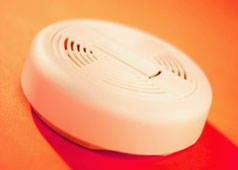Smoke Detector
Records Building - 500 Elm Street, Suite 0500, Dallas TX 75202
Phone: (214) 653-7970
Smoke Detectors!!!
 In addition to changing your smoke alarm batteries this weekend, the USFA recommends following these simple steps to protect your life, your loved ones, and your home:
In addition to changing your smoke alarm batteries this weekend, the USFA recommends following these simple steps to protect your life, your loved ones, and your home:- Dust or vacuum smoke alarms when you change the batteries.
- Test alarms once a month using the test button.
- Replace the entire alarm if it is more than 10 years old or does not work properly when tested.
- Install smoke alarms on every level of your home, including the basement, and both inside and outside of sleeping areas.
- For the best protection, equip your home with a combination of ionization and photoelectric smoke alarms or dual sensor alarms.
- Interconnect all smoke alarms throughout your home so that when one sounds, they all sound. Interconnected alarms are available at most stores that sell smoke alarms.
- Make sure everyone in your home understands the warning of the smoke alarm and knows how to respond.
Finally, prepare and practice an escape plan so that you and your loved ones can get out of your home safely should there be a fire. Plan to meet in a place a safe distance from the fire and where first responders can easily see you.
For more information on smoke alarms, fire escape planning, and fire prevention, visit the USFA website at www.usfa.fema.gov/smokealarms.
Texas State Fire Marshal’s Office
http://www.tdi.state.tx.us/fire/index.html
Regulations/Standards
There are many different brands of smoke alarms available on the market but they fall under two basic types: ionization and photoelectric.
Ionization alarms sound more quickly when a flaming, fast moving fire occurs.
Photoelectric alarms are quicker at sensing smoldering, smoky fires. There are also combination smoke alarms that combine ionization and photoelectric into one unit, called dual sensor smoke alarms.
Because both ionization and photoelectric smoke alarms are better at detecting distinctly different yet potentially fatal fires, and because homeowners cannot predict what type of fire might start in a home, the USFA recommends the installation of both ionization and photoelectric or dual sensor smoke alarms. In addition to the basic types of alarms, there are alarms made to meet the needs of people with hearing disabilities. These alarms may use strobe lights that flash and/or vibrate to assist in alerting those who are unable to hear standard smoke alarms when they sound.
Installation
General guidelines for smoke alarm placement:
Smoke rises
Place your smoke detector on or near the ceiling. Make sure you place your detector at least three feet away from any  air vents so smoke doesn’t get blown away before the detector can sense it.
air vents so smoke doesn’t get blown away before the detector can sense it.
Check your batteries
Test your detector once a month, and replace your batteries once a year. To test most detectors, you either push a button or shine a light. It may be helpful to connect this with a regular event such as payday. Pick an annual event, like New Year’s Day or daylight savings time, to replace your batteries - even if they still work. Never disconnect your smoke detector or “borrow” the batteries for something else.
Again, follow the manufacturer’s directions. If your detector “chirps” it’s probably time to replace the batteries. If you rent, ask your landlord how to check the batteries and maintain the detector when you move in.
Put at least one detector in each sleeping area.
One detector per sleeping area is the absolute minimum. If all the bedrooms in your home share a single hallway, place the smoke detector in the hall outside the rooms. You should have an additional detector outside every bedroom that doesn’t share a common hallway. If you sleep with the door closed, put another detector inside the bedroom. On floors without bedrooms, place detectors in or near living areas.
A good place for a smoke detector in a two-story house is at the top of the stairs since smoke from downstairs will rise along that path. Follow the manufacturer’s directions. The instructions will show you exactly where and how to install your smoke detector.
Guidelines for connecting the smoke alarm:
If your smoke alarms are hard wired, that is wired into the electrical system, you will need to have a qualified electrician do the initial installation or install replacements. For battery powered smoke alarms, all you will need for installation is a screw driver. Some brands are self adhesive and will easily stick to the wall or ceiling where they are placed.
For all smoke alarm installations, be sure you follow the manufacturer’s instructions because there are differences between the various brands. If you are uncomfortable standing on a ladder, ask a relative or friend for help. Some fire departments will install a smoke alarm in your home for you. Call your local fire department (on a non-emergency telephone number) if you have problems installing a smoke alarm.
Some smoke alarms are considered to be “hard-wired.” This means they are connected to the household electrical system and may or may not have battery backup. It’s important to test every smoke alarm monthly and replace the batteries with new ones at least once a year.
For more information please visit: http://www.tdi.state.tx.us/fire/fmcoalarms.html
Contact:
Paul Maldonado State Fire Marshal
Texas Department of Insurance State Fire Marshal's Office
P.O. Box 149221 Austin,
TX 78714-9221
Tel: 512-305-7900
Fax: 512- 305-7910
Email: Fire.Marshal@tdi.state.tx.us
QUICK LINKS
LOCATIONS
EMPLOYEES
-
You must be on the network to see these links.

